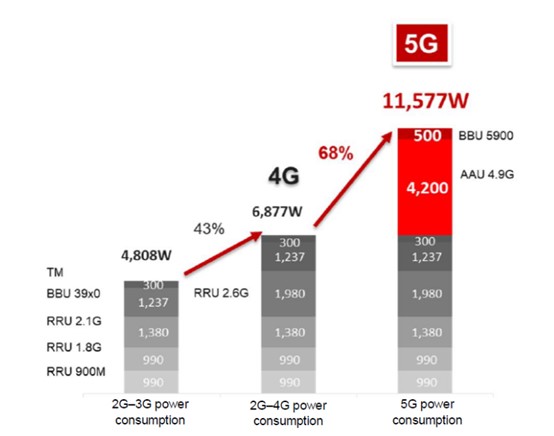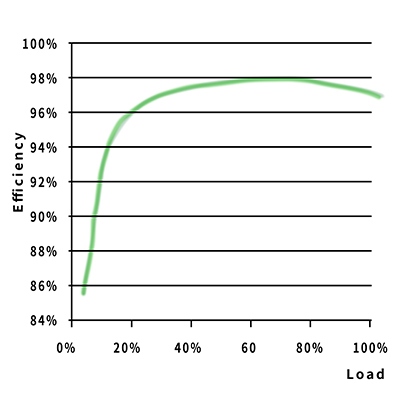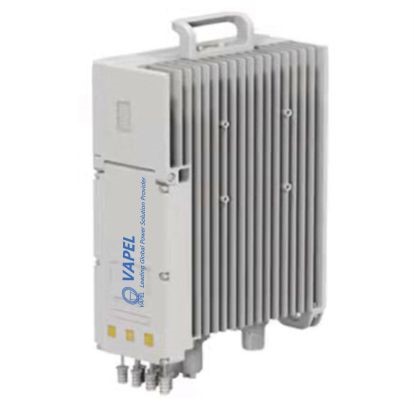Although covid-19 still seriously affectsthe lives of people all over the world, it still cannot stop the upsurge of 5G communication construction all over the world. The application of 5G will alsohave a far-reaching impact on the lives of people all over the world. Comparedwith the existing 3G and 4G communication, 5G communication has thecharacteristics of ultra-high rate and very low delay. The reason for thesecharacteristics is that 5G communication adopts a higher frequency spectrum.The higher the frequency, the smaller the coverage area of the communication signals for wireless communication. On the one hand, the density of 5G communication base stations needs to be higher. On the other hand, a singlecommunication base station needs to adopt Massive MIMO (64T64R, 128T128T, etc.)and beamforming technologies to solve the problems of small signal coverage.These new technologies and applications put forward higher requirements for thenatural heat dissipation capacity and maintenance cost of communication switching power supply. At the same time, 5G's rich networking architecture andlayout bring more power supply modes and combinations, including AC (UPS)direct power supply, - 48V power supply, HVDC (high voltage DC) power supply,etc.
As we all know, 3GPP in 5G standard definesthree scenarios for use: EMBB, high flow mobile broadband services such as 3D /UHD video. MMTC, large scale Internet of things business. And URLLC, such asdriverless, industrial automation and other services requiring low delay andhigh reliable connection.
5G communication includes access network,bearer network and core network. Today, we mainly discuss the impact of radioaccess network (RAN-Radio Access Network) on switching power supply. Thewireless access network is mainly composed of base stations, including BBU(mainly responsible for signal modulation), RRU (mainly responsible for RFprocessing), feeder (connecting RRU and antenna), and antenna (mainlyresponsible for the conversion between guided traveling wave on cable and spacewave in air). The 4G base station is composed of BBU and RRU. The 5G basestation is mainly composed of BBU, RRU and AAU, as well as CU + DU + RRU + AAU.
ELTE evolution is an important part of 5G.Therefore, the construction of 5G needs to be compatible (retained) with theexisting 3G and 4G communication for a long time, and the micro site and macrosite will increase greatly. Therefore, most of them adopt the transformationand upgrading of the existing base stations and central offices, which meansthat the communication switching power supply needs to supply power to 3G / 4Gand 5G communication equipment at the same time to reduce the output power ofthe communication switching power supply, new requirements are put forward forpower density and reliability.
5G communication base stations aredeveloping from macro base stations to micro base stations. "Macro station+ micro station" has become a new 5G mode, and the proportion of microbase stations is expected to increase significantly.
Let's briefly introduce the functions anddifferences between AAU and RRU.
AAU (active antenna processing unit) is anew type of equipment introduced into 5G network framework, which is differentfrom RRU (radio frequency remote unit).
RRU (radio frequency remote function)appeared in the 3G era. In the 4G era, the traditional integrated macro basestation has been completely replaced by the BBU + RRU + antenna mode, and someBBUs are uniformly placed in a computer room to form a BBU pool.
In the 5G era, new changes have taken placein the structure of the base station, and a new equipment AAU has emerged. Thereason for the emergence of AAU in 5G is that 5G introduces the technology ofmassive MIMO. Massive MIMO, large-scale multiple input and multiple output. Byintegrating the RRU and the original passive antenna, the latest AAU (activeantenna processing unit) is formed. With the integrated antenna, the volume andweight of the AAU are larger than that of the RRU, the power consumption isalso greatly increased, and the price is much more expensive.
AAU also has some functions of BBU. In the 5Gera, not only the RRU and antenna are integrated into AAU, but also thephysical structure of BBU has evolved into CU (centralized unit) and DU(distributed unit) due to the changed network framework of 5G. The part withstrong real-time performance of BBU has become DU (distributed unit), while thenon-real-time function of BBU has evolved into CU (centralized unit). Inaddition, 5G core network functions sink to the edge, and CU will also carrythe functions of some core networks. Some physical layer functions of BBU aredesigned into AAU. Therefore, compared with RRU, AAU is not only the functionof multi integrated antenna, but also the function of some physical layer ofBBU.
There will still be RRU in 5G. There arealso some low-frequency parts in 5G, such as 700MHz to be used by radio andtelevision. Due to the large wavelength and large antenna array, it isdifficult to support large-scale antenna array. Moreover, in some areas that donot require high system capacity, such as rural and mountainous areas, it isnot necessary to use expensive AAU. Therefore, in the whole network structureof 5G In the architecture, there will still be the combination of BBU + RRU +traditional antenna, and AAU is not the only 5G system. Moreover, for areas where AAU is not deployed, 2 / 3 / 4 / 5G can be deployed and fully integratedinto the base station with the same set of BBU + RRU + antenna, which can alsoreduce the cost for operators to deploy 5G network.

Comparedwith 4G, 5G macro base station has the following difficulties: first, the system architecture of 5G base station is differentfrom that of 4G base station. Second, due to the increase of frequency, thepower consumption of 5G base station is several times that of 4G base station,which greatly increases the difficulty of introducing mains power, and reducingthe power consumption of base station has become an important topic. Third, thedifficulty of direct power supply for base stations has increased, andhigh-voltage DC remote power supply has become a trend. Fourth, the increase ofpower consumption leads to a significant increase in the battery capacity ofthe base station, especially the capacity of backup batteries, which isdifficult to accommodate in the existing space. It is necessary to selectbatteries with higher energy density, such as lithium iron phosphate batteries.Fifth, the environment of 5G base station is poor, and it is difficult to useand maintain air conditioning. Air conditioning free base station isimperative, and the bottleneck of air conditioning free base station lies inpower supply and battery.
High voltage DC remote supply has become anideal power supply mode for 5G macro base station. In view of the problemsexisting in the supporting power supply of 5G macro base station, high-voltageDC remote power supply has become an ideal power supply mode. In addition,through the combination of power supply and battery, the battery can replacethe power supply for peak shaving power supply, so as to reduce the demand ofthe base station for external power. In terms of the standby power supply ofthe base station, it should be changed to batteries with high energy densityand good environmental adaptability, such as lithium batteries, and thecombination of far and near standby power and high-voltage DC remote powersupply should be adopted. Small peak shaving batteries should be equipped atthe near end, and multi station shared large batteries should be equipped inthe remote communication room or large base station to realize the centralizedsharing mode of battery standby power.
There are various power supply schemes formicro base stations. Compared with macro base stations, micro base stationshave less power consumption and different power supply modes. According to theimportance level of the station, the power supply construction scheme of themicro base station can be divided into two categories: with backup power supplyguarantee and without backup power supply guarantee. For stations that do notneed backup power supply, 220VAC direct power supply (mains power supplyscheme) or POE power supply scheme can be selected according to the powersupply type of equipment. For micro base stations that need backup powersupply, the power supply scheme adopts the following principles: (1) 48V DCpower supply is preferred, followed by 280VDC remote power supply, and finallysmall and micro power supply is configured nearby. (2) When the route lengthbetween the micro base station and the source machine room is ≤ 100m, it isrecommended to select the 48V DC direct supply scheme. (3) When the routelength between the micro base station ≤ 100m and the sourcemachine room ≤ 300m, the 48V DC direct supply scheme is preferred by thickeningthe power supply cable diameter. Secondly, 220VDC remote supply scheme isselected. (4) When the route length between the micro base station and thesource machine room is ≥ 300m, the 280VDC remote power supply scheme is considered. Whenthere are too many cables or it is difficult to lay and route, the scheme ofconfiguring small and micro power supply nearby can be used to power the microbase station equipment.
Microbase station will gradually become the mainstream base station mode in 5G era. 5G communication adopts ultra-dense networking technology due toits high frequency. For macro base stations, the coverage of high frequency istoo small, which makes the cost too high. In addition, it is difficult todeploy macro base stations, and the site resources are not easy to obtain.Therefore, in 5G networks, the probability of using macro base stations forhigh-frequency resources will decline, and microcells are expected to becomethe mainstream, with small base stations as the basic unit, Conductultra-intensive networking and intensive deployment of small base stations.With the increasing penetration of 5G, a large number of small base stationsneed to be used to complete more in-depth and wide coverage. In the future,small base stations are expected to show explosive growth.
To sum up, we can see that 5G communication brings many challenges to switching power supply.
A. Higher output power and higher efficiency.
As the 5G base station AAU adopts themassive MIMO (large-scale multiple input multiple output) technology and isconfigured with 64T / 64R antenna array, the average power consumption of asingle channel is lower than that of the traditional 8T / 8R 4G antenna. However,due to the significant increase in the number of channels, the maximum power consumption of a single AAU will reach 1000-1400W (a single base station isgenerally configured with 3 AAUs), In addition, the increase in the amount ofcomputation of 5G base stations will further improve the BBU power, and thepower consumption of 5G base stations may reach 3-4 times that of 4G basestations.
The AAU single sector output power of 5G base station has increased from 40W ~ 80W of 4G to 200W or even higher. At thesame time, due to the significant increase in the amount of data processed, thepower of BBU (baseband processing unit) (or split into CU and DU in somenetworking modes of 5G) has also increased significantly, and its power hasexceeded 1000W. For the popular networking mode of 5G base station: 3 sectorAAU + 1 BBU, assuming that the AAU efficiency is 20%, the output power of the switchingpower supply supplying power to 5G base station alone is about: P_out=(3*200)/0.2+1000=4000W.
The output power of the switching powersupply supplied by the original 4G communication base station is 2000W ~ 3000W.The output power is greatly increased. According to the data provided by one of the world famous telecommunication instrument manufacturer., the power consumption of 3G (2G compatible), 4G (3Gcompatible) and 5G (3G and 4G compatible) base stations is shown in the figurebelow. After adding 5G communication, the power of the base station powersupply increases by 68%.

The increased demand for electric energy by 5G communication means higher requirements for the efficiency of communication switching power supply, so as to reduce the communication operation cost(OPEX). According to the statistical data of China Unicom, the electricitycharge accounts for 28% in the OPEX of communication data center (CentralBureau computer room). Although the energy consumption of the power supply system accounts for only 10% of the total energy consumption of thecommunication data center, the power supply system will aggravate the burden ofthe refrigeration system. Taking the 30kW system as an example, an increase of 5% in efficiency can reduce the power consumption of power supply equipment by 18000KWH and air conditioning power consumption by 7200 KWH a year. Improving the conversion efficiency of communication switching power supply is one of thekey means to reduce the cost of the communication data center.
Compared with 3G / 4G communication, the data traffic of 5G communication becomes more unbalanced. The traffic may begreat in a certain period and small in a certain period, which means that theactual load range of communication switching power supply will be from lightload to full load. For 5G communication switching power supply, in order toensure that the power consumption of the communication system reaches the lowest value under any load, the requirement of efficiency is no longer toreach the highest value under a certain load, but to reach the highest value in a wide range, and the efficiency curve becomes a relatively stable straightline, as shown in the figure below.

B. High power density.
As mentioned earlier, for communicationdata centers and macro base stations, most of them adopt the way of capacity expansion of existing equipment to build 5G communication equipment. Amongthem, the space left for the power cabinet for 5G communication is often extremely limited, and even the original power cabinet can only be used. Inthese cases, the output power of the power cabinet needs to be greatly increased.This requires that the output power of the communication switching power supply module (commonly known as the rectifier module) increases greatly while keepingthe volume basically unchanged, that is, the power density increases. Forexample, the size of a large number of 3KW output rectifier modules used in 4G communication is 280mm * 105mm * 40mm (length * width * height), and its powerdensity is:
ρ= 3000/((280/25.4)*(105/25.4)*(40/25.4))=42W/in^3
In order to be applied to 5G communication,the output power needs to reach 4KW under the condition of unchanged size, sothe power density is:
ρ= 4000/((280/25.4)*(105/25.4)*(40/25.4))=56W/in^3
VAPEL has released the new 4KW highefficiency rectifier module together with the 48Vdc power system to help thedevelopment of 5g communication.
For the 5G micro base station, the powersupply of AAU adopts the pole design, and VAPEL has launched the blade 5G communication switching power supply (as shown in the figure below). In order to reduce theweight and size of the overall box, the size and height of the internal power supply are required to be as small as possible (≤ 40mm). Accordingly,the power density of the power supply needs to be greatly improved.

C. Higher heat dissipation requirements,such as natural heat dissipation
In 5G communication, the number of micro(small) base stations will increase greatly. Most of the power supply of thesemicro base stations will be installed in confined space, as shown in the abovefigure, so as to meet the protection grade of IP65, so they can be installed inoutdoor, field and other environments. Because it is installed in a confined space, this kind of communication switching power supply can only be used inthe way of natural heat dissipation (no forced air cooling or no watercooling). At the same time, the output power of 5G communication switching power supply is larger than 3G / 4G communication system, which brings greater challenges to the heat dissipation design of communication switching power supply.
D. High reliability
As the heart of communication system, thereliability of communication switching power supply determines the reliabilityof the whole system. 5G communication will be used in important occasions suchas automatic driving, intelligent manufacturing and artificial intelligence.Therefore, 5G Communication puts forward higher requirements for thereliability of communication switching power supply system. At the same time,as described above, 5G communication will have a large number of micro (small)base stations. If batch failure occurs, the maintenance cost will be surprisingly high. In order to reduce the maintenance cost and improve thereliability of power supply, it is one of the main requirements for 5G communicationswitching power supply.
Thereliability of switching power supply can be designed and improved from thefollowing aspects:
(1) Adopt mature and efficient topology, improve the core algorithm DSP control, and adopt new technology to improve the heat dissipation efficiency.
(2) In the design stage, simulation experiments are carried out inadvance, such as heat dissipation fluid simulation (Flotherm) and circuit simulation (PSPICE). Conduct reliability test before mass production, such as 1. Thermal shock test, 2. THB (temperature humidity bias), 3. HTOL (high temperature operation life), 4. Power thermal cycle.
(3) Select high-quality devices. The quality of the device itself is fundamental, and high-quality devices can form high-quality switching power supply. Selecting devices of regular and reputable brands is the first step in designing high reliability products.
(4) Strictly meet the specification and derating requirements of devices.Each device has its specification and must not be used beyond the specification. At the same time, in order to ensure the service life and failure rate of the system, a certain derating is required. The service life of insulation and capacitance of power semiconductors and magnetic components are strongly related to their working temperature. If there is no derating, thefailure efficiency and service life will increase greatly. There is ipc9592 in theindustry such standards can be used as a derating reference.
(5) Improve the test items. The test in the design stage is animportant step to verify the reliability of the product. The test should try to simulate the actual application conditions. For example, for 5G communication switching power supply, dynamic load test is very important because of its large load fluctuation. For outdoor power supply, lightning surge test is very important because it may suffer lightning stroke.
If you have switching power supply requirements for 5G or telecommunication related products or have relevant technical problems, please contact us, we will sincerely provide you with our high-quality products and services. Not only the standard product, VAPEL can also provide high-quality customized power supply services professionally.